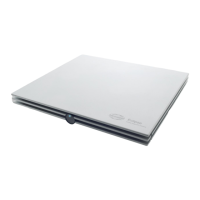Eclipse Additional Information Page 21
4. Manual Stimulation: The Man. Stim window allows you at any time, also before the test starts, to over-
rule the automatic test protocol you have selected: Select ear and click on one or more intensities. If an auto-
matic test sequence is in progress, the manually entered intensities will be tested as soon as the automatic
intensity sequence has finished. After the manually entered intensities are tested, the instrument will stop. If
you hit Start again, the remaining part of the automatic test sequence will resume. During recording the
dropdown intensity box can be used to add extra intensities. If is checked it the general
setup. The marked intensity will stay on after Start is pressed.
3.4.3 Rejection level
It may be necessary to adjust the rejection level prior to starting the test.
Note while measuring surface electrode impedances full rejection takes place.
Note if one or more surface electrode is disconnected before and during recording full rejection takes place.
By clicking on the arrows to the left of the raw EEG curve you will manually set the input rejection level to a
level where the curves will be accepted (typically 40µV or less). Rejected curves turn red. High frequency
content in the signal is not visible on the Raw EEG curve but may still cause rejection.
There is no exact input rejection value as this depends on patient and electrical interference for this test time
and test location. The rejection level should be modified until the raw EEG curve is not red. A black EEG
curve indicates that the system is ready to measure. But be advised that the higher the rejection, the more
noise is allowed and recorded. Always use the lowest rejection setting possible without rejection or trouble-
shoot to minimize the noise.
e.g. Adult ±40µV and children/neonates ±20µV
No recordings can be made if the system rejects the signal. If considerable or total rejection occurs with
the reject level set to a reasonable value check electrode impedances and that the patient is relaxing and not
tensing muscles. Muscle pain or tensed muscle due to neck problems or uncomfortable patient position will
disturb the ABR recordings as these muscles are close to the recording site. When either or both EEG
curves are shown in red rejection occurs.
When a rejection level is chosen the gain is also set, which is shown in the adjustment of the rejection level
in the System Setup | Auto Protocols. Below is the relation between rejection level and gain.

